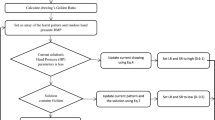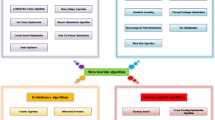Abstract
Crow search algorithm (CSA) is a new natural inspired algorithm proposed by Askarzadeh in 2016. The main inspiration of CSA came from crow search mechanism for hiding their food. Like most of the optimization algorithms, CSA suffers from low convergence rate and entrapment in local optima. In this paper, a novel meta-heuristic optimizer, namely chaotic crow search algorithm (CCSA), is proposed to overcome these problems. The proposed CCSA is applied to optimize feature selection problem for 20 benchmark datasets. Ten chaotic maps are employed during the optimization process of CSA. The performance of CCSA is compared with other well-known and recent optimization algorithms. Experimental results reveal the capability of CCSA to find an optimal feature subset which maximizes the classification performance and minimizes the number of selected features. Moreover, the results show that CCSA is superior compared to CSA and the other algorithms. In addition, the experiments show that sine chaotic map is the appropriate map to significantly boost the performance of CSA.





Similar content being viewed by others
References
Abdullah A, Enayatifa R, Lee M (2012) A hybrid genetic algorithm and chaotic function model for image encryption. Journal of Electronics and Communication 66(1):806–816
Askarzadeh A (2016) A novel metaheuristic method for solving constrained engineering optimization problems: crow search algorithm. Comput Struct 169:1–12
Bache K, Lichman M UCI Machine learning repository. http://archive.ics.uci.edu/ml. Retrieved July 19, 2016
Blum A, Langley P (1997) Selection of relevant features and examples in machine learning. Artif Intell 97:245–271
Cai JJ, Ma XQ, Li X (2007) Chaotic ant swarm optimization to economic dispatch. Electr Power Syst Res 77(10):1373–1380
Chen CH (2014) A hybrid intelligent model of analyzing clinical breast cancer data using clustering techniques with feature selection. Appl Soft Comput 20:4–14
Derrac J, García S, Molina D, Herrera F (2011) A practical tutorial on the use of nonparametric statistical tests as a methodology for comparing evolutionary and swarm intelligence algorithms. Swarm Evol Comput 1(1):3–18
Emary E, Zawbaa H, Hassanien A (2016) Binary gray wolf optimization approaches for feature selection. Neurocomputing 172:371–381
Figueiredo E, Ludermir T, Bastos C (2016) Many objective particle swarm optimization. Inf Sci 374:115–134
Gadat S, Younes L (2007) A stochastic algorithm for feature selection in pattern recognition. Journal of Machine Learning 8:509–547
Gai-Ge W, Suash D, Leandro D, Coelho S (2015) Elephant herding optimization 3rd international symposium on computational and business intelligence (ISCBI), Bali, pp 1–5
Gandomi A, Yang X, Alavi A (2011) Mixed variable structural optimization using firefly algorithm. Comput Struct 89:2325–2336
Gandomi AH, Yang XS, Talatahari S, Alavi AH (2013) Firefly algorithm with chaos. Commun Nonlinear Sci Numer Simul 18(1):89–98
Geem Z, Kim J, Loganathan G (2001) A new heuristic optimization algorithm: harmony search. Simulation 76(2):60–68
Goldberg D (1989) Genetic algorithms in search, optimization and machine learning, 1st edn. Addison-Wesley Longman Publishing Co., Inc., Boston, MA, USA. ISBN 0201157675
Golub TR (1999) Molecular classification of cancer: class discovery and class prediction by gene expression monitoring. Science 286:531–537
Guyon I, Elisseeff A (2003) An introduction to variable and attribute selection. Machine Learning Research 3:1157–1182
Hafez AI, Zawbaa HM, Emary E, Mahmoud HA, Hassanien AE (2015) An innovative approach for feature selection based on chicken swarm optimization 7th international conference of soft computing and pattern recognition (SoCPaR), pp 19–24
Hafez AI, Zawbaa HM, Emary E, Hassanien AE (2016) Sine cosine optimization algorithm for feature selection International symposium on inovations in intelligent systems and applications (INISTA), pp 1–5
He YY, Zhou JZ, Zhou XQ (2009) Comparison of different chaotic maps in particle swarm optimization algorithm for long term cascaded hydroelectric system scheduling. Chaos Solitons Fractals 42:3169–1376
He YY, Zhou JZ, Li CS (2008) A precise chaotic particle swarm optimization algorithm based on improved tent map. ICNC 7:569–573
He Y, Zhou J, Lu N, Qin H, Lu Y (2010) Differential evolution algorithm combined with chaotic pattern search. Kybernetika 46(4):684–696
Jia H, Ding S, Du M, Xue Y (2016) Approximate normalized cuts without Eigen-decomposition. Inf Sci 374:135–150
Jian L, Li J, Shu K, Liu H (2016) Multi-label informed feature selection Proceedings of the twenty-fifth international joint conference on artificial intelligence, pp 1627–1633
Kaveh A, Talatahari S (2010) A novel heuristic optimization method: charged system search. Acta Mech 213:267–289
Kennedy J, Eberhart R (1995) Particle swarm optimization IEEE international conference on neural networks, vol 4, pp 1942–1948
Kohavi R, John G (1997) Wrappers for feature subset selection. Artif Intell 97(1):273–324
Lei Y, Huan L (2003) Feature selection for high-dimensional data: a fast correlation-based filter solution Proceedings of the 20th international conference on machine learning (ICML-03), pp 856–863
Li B, Jiang W (1998) Optimizing complex functions by chaos search. Journal of Cybernetics and Systems 29:409–419
Li X, Zhang J, Yin M (2013) Animal migration optimization: an optimization algorithm inspired by animal migration behavior, Neural Comput Applic, pages=1–11
Lin S, Ying KS-C, Lee Z (2008) Particle swarm optimization for parameter determination and feature selection of support vector machines. Expert Syst Appl 35(4):1817–1824
Meng X, Gao XZ, Lu L, Liu Y, Zhang H (2016) A new bio-inspired optimisation algorithm: bird swarm algorithm. J Exp Theor Artif Intell 28(4):673–687
Mingjun J, Tang HW (2004) Application of chaos in simulated annealing optimization. Chaos Solitons Fractals 21:933–941
Mirjalili S, Seyed M, Lewis A (2014) Grey wolf optimizer. Adv Eng Softw 69:46–61
Ng K, Liu H (2000) Customer retention via data mining. AI Review 14:569–590
Repinsek M, Liu S, Mernik L (2012) A note on teaching–learning-based optimization algorithm. Inf Sci 212:79–93
Rui Y, Huang TS, Chang S (1999) Image retrieval: current techniques, promising directions and open issues. J Vis Commun Image Represent 10:39–62
Sarafrazi S (2013) Facing the classification of binary problems with a gsa-svm hybrid system. Math Comput Model 57:270–278
Saremi S, Mirjalili S, Lewis A (2014) Biogeography-based optimization with chaos. Neural Comput & Applic 25(5):1077–1097
Sayed G, Darwish A, Hassanien A, Pan S (2016) Breast cancer diagnosis approach based on meta-heuristic optimization algorithm inspired by bubble-net hunting strategy of whales 10th international conference on genetic and evolutionary computing (ICGEC), Fujian, China, pp 306–313
Sayed S, Nabil E, Badr A (2016) A binary clonal flower pollination algorithm for feature selection. Pattern Recogn Lett 77:21–27
Schiezaro M, Pedrini H (2013) Data feature selection based on artificial bee colony algorithm. EURASIP Journal on Image and Video Processing 2013(1):1–8
Shilaskar S, Ghatol A (2013) Feature selection for medical diagnosis: evaluation for cardiovascular diseases. Expert Syst Appl 40(10):4146–4153
Storn R, Price K (1997) Differential evolution -a simple and efficient heuristic for global optimization over continuous spaces. J Glob Optim 11(4):341–359
Tavazoei MS, Haeri M (2007) Comparison of different one-dimensional maps as chaotic search pattern in chaos optimization algorithms. Appl Math Comput 187:1076–1085
Unler A, Murat A (2010) A discrete particle swarm optimization method for feature selection in binary classification problems. Journal of Operation Research 206:528–539
Wanga G, Guo L, Gandomi A, Hao G, Wangb H (2014) Chaotic krill herd algorithm. Inf Sci 274:17–34
Wilcoxon F (1945) Individual comparisons by ranking methods. Biom Bull 1:80–83
Yuan XH, Yuan YB, Zhang YC (2002) A hybrid chaotic genetic algorithm for short-term hydro system scheduling. Math Comput Simul 59(4):319–327
Xiang T, Liao XF, Wong KW (2007) Comparison of different chaotic maps in particle swarm optimization algorithm for long term cascaded hydroelectric system scheduling. Appl Math Comput 190:1637–1645
Yang DX, Li G, Cheng GD (2007) On the efficiency of chaos optimization algorithms for global optimization. Chaos Solitons Fractals 34:1366–1375
Yang Y, Pederson JO (1997) A comparative study on feature selection in text categorization Proceedings of the fourteenth international conference on machine learning, pp 412–420
Yu Z (2014) Hybrid clustering solution selection strategy. Pattern Recogn 47:3362–3375
Yuan XF, Wang YN, Wu LH (2007) Pattern search algorithm using chaos and its application. Journal of Hunan University, Natural Sciences 34(9):30–33
Zawbaa H, Emary E, Parv B, Shaarawi M (2016) Feature selection approach based on moth-flame optimization algorithm IEEE congress on evolutionary computation, Vancouver, Canada, pp 24–29
Zhang H, Sun G (2002) Feature selection using tabu search method. Pattern Recogn 35:701–711
Zhang L, Zhang CJ (2008) Hopf bifurcation analysis of some hyperchaotic systems with time-delay controllers. Kybernetika 44(1):35–42
Zhang N, Ding S, Zhang J (2016) Multi layer elm-rbf for multi-label learning. Appl Soft Comput 43:535–545
Zhang Q, Li Z, Zhou CJ, Wei XP (2013) Bayesian network structure learning based on the chaotic particle swarm optimization algorithm. Genet Mol Res 12(4):4468–4479
Zhu ZL, Li SP, Yu H (2008) A new approach to generalized chaos synchronization based on the stability of the error system. Kybernetika 44(4):492–500
Author information
Authors and Affiliations
Corresponding author
Ethics declarations
Conflict of interest
The authors declare that they have no conflict of interest.
Additional information
Scientific Research Group in Egypt http://www.egyptscience.net
Rights and permissions
About this article
Cite this article
Sayed, G.I., Hassanien, A.E. & Azar, A.T. Feature selection via a novel chaotic crow search algorithm. Neural Comput & Applic 31, 171–188 (2019). https://doi.org/10.1007/s00521-017-2988-6
Received:
Accepted:
Published:
Issue Date:
DOI: https://doi.org/10.1007/s00521-017-2988-6




